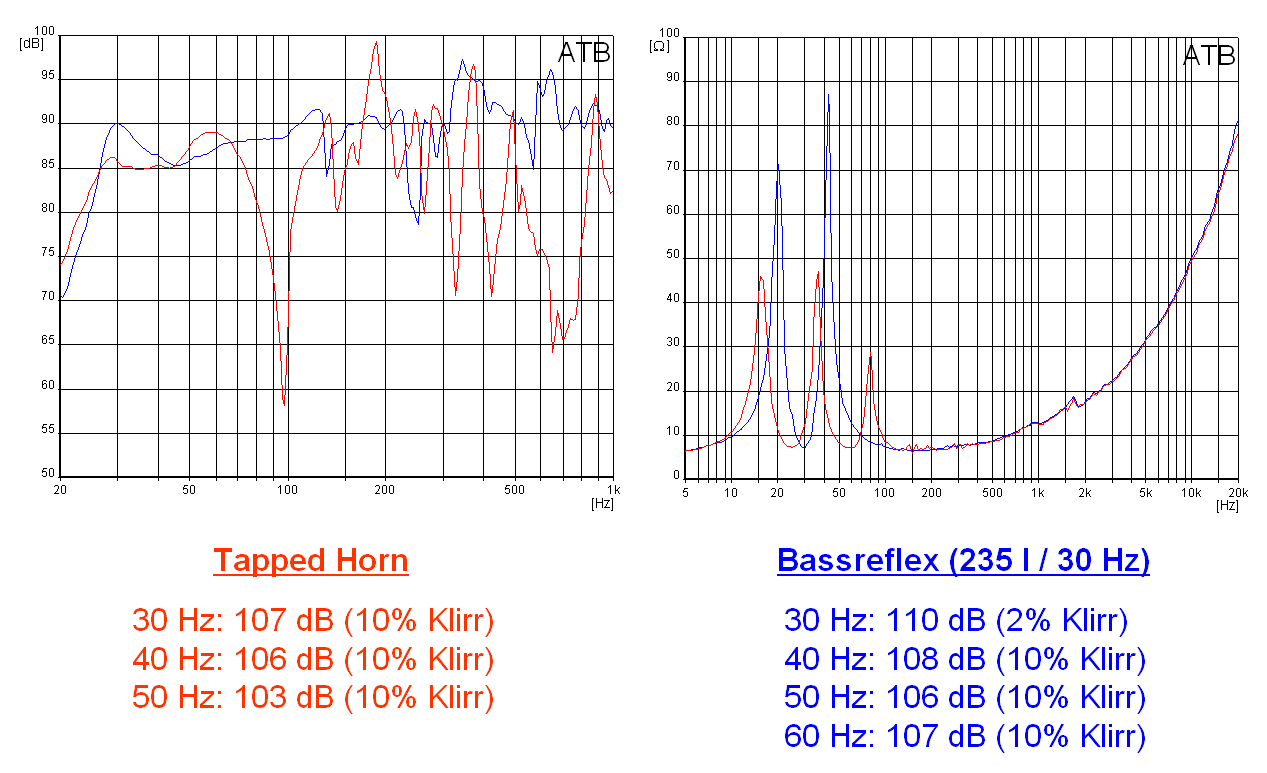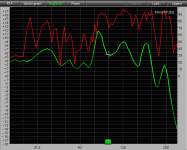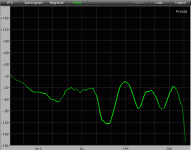Don Snyder said:One would think that DSP holds the answer to the "High Power Sine Wave" problem ...
How about it? Do you have the answer?
Don
I think the Behringer DSP has a level dependant equalizer. You could dial it into the lowest excursion maximum of the tapped horn and limit maximum output there.
Apart from that, i think one simply has to accomodate for the fact that most music has deep low tones, and this is since synthesizers are used in most genres out there, in the system design. Hard to pull of a "Sorry, but you can only play acoustic string bass over my subs" if you want to do live events
 If not, just build what you need.
If not, just build what you need.MaVo said:
I think the Behringer DSP has a level dependant equalizer. You could dial it into the lowest excursion maximum of the tapped horn and limit maximum output there.
Yes it does and it´s one of the things I do when I´m the tech myself and have everythin under controll... But you have to know exactly how your system behaves, otherwise it´s useless. Even swithcing my amps is difficult, so I only do it with the one system which never changes
Great pictures! And a very interesting thread.
Someone mentioned EP2500 - I use this amp in my system, now as the main amp and prevously to drive some power hungry subs. Compared to some other lesser powered amps (Alesis and QSC both with 450w), the Behringer had a noticedable increase in headroom. I've only once managed to get it to clip, the others went into clipping the first time I tried them. I've seen independent tests, and this amp performs as well as (and in some cases slightly better) than many other amps including Crown when it comes to living up to their power ratings. They all measure below their ratings - it seems they know what to do to get the figure higher. It's like max SPL ratings on pro speakers. A fairly optimistic figure.
Is the Lab 12 a good driver for TH use?
I'm curious as I have two drivers which are similar (except double the xmax) - they are sitting on the HT floor looking pretty at the moment.
Regarding vented vs TH, it's my understanding that a tapped horn can increase efficiency and extension over a broader range with a bigger box. A vented box requires a certain size to gain extension, and once that size is reached, there is no further efficiency gain by making the box bigger. The vent gives a narrow band of gain, yielding an extra octave of extension, but above that we rely on the direct radiator efficiency of the driver. A TH increases effiency over it's entire bandwidth.
I recall Danley stating on a forum post that a TH can increase sensitivity by 10 db and reduce excursion by a factor of 4.
Regarding how this TH sounds, I'm curious to hear your thoughts on how it compares to other subs. What have you heard that sounds similar? Have you heard something that sounds better?
Someone mentioned EP2500 - I use this amp in my system, now as the main amp and prevously to drive some power hungry subs. Compared to some other lesser powered amps (Alesis and QSC both with 450w), the Behringer had a noticedable increase in headroom. I've only once managed to get it to clip, the others went into clipping the first time I tried them. I've seen independent tests, and this amp performs as well as (and in some cases slightly better) than many other amps including Crown when it comes to living up to their power ratings. They all measure below their ratings - it seems they know what to do to get the figure higher. It's like max SPL ratings on pro speakers. A fairly optimistic figure.
Is the Lab 12 a good driver for TH use?
I'm curious as I have two drivers which are similar (except double the xmax) - they are sitting on the HT floor looking pretty at the moment.
Regarding vented vs TH, it's my understanding that a tapped horn can increase efficiency and extension over a broader range with a bigger box. A vented box requires a certain size to gain extension, and once that size is reached, there is no further efficiency gain by making the box bigger. The vent gives a narrow band of gain, yielding an extra octave of extension, but above that we rely on the direct radiator efficiency of the driver. A TH increases effiency over it's entire bandwidth.
I recall Danley stating on a forum post that a TH can increase sensitivity by 10 db and reduce excursion by a factor of 4.
Regarding how this TH sounds, I'm curious to hear your thoughts on how it compares to other subs. What have you heard that sounds similar? Have you heard something that sounds better?
For me a TH brings two worlds together: Efficinecy and clarity, rich details of a front loaded horn and the compact sizes of bigger Vented Boxes plus the capability to run single, which many horns don´t have.Regarding how this TH sounds, I'm curious to hear your thoughts on how it compares to other subs. What have you heard that sounds similar? Have you heard something that sounds better?
A sloppy build TH can sound worse than a good vented box, but as soon as you "do it right", it´s two different worlds IMHO.
A lot of good frontloaded horns can sound very good, too and depending on the music you listen to might be better suited, but also at the extend of having much more volume with the boxes.
The thing that sounded the best so far was a veeeery big stack of very small sealed 10"... Increase of radiation resistance because of a lllooooot of Sd is the key here... These Systems are very clean but require way too much material and volume.
paulspencer said:Is the Lab 12 a good driver for TH use?
I'm curious as I have two drivers which are similar (except double the xmax) - they are sitting on the HT floor looking pretty at the moment.
The Lab12 has too soft a suspension and too low Fs. It's a good driver for the money, and available.
As far as your "similar" drivers, only Hornresp knows. Download a copy and check them out.
Good Luck,
Don
Don Snyder said:
The Lab12 has too soft a suspension and too low Fs.
For prosound, but not HIFI/HT if size isn't a major issue.
GM
Re: some measurements
Thanks, which one, Don's?
GM
CrazyTubax86 said:i measured the one that me and chris (my brother) built:
Thanks, which one, Don's?
GM
@GM - Yes, the same config as the opening post in this thread. Chris built two cabinets using OSB.
@CrazyTubax86 - Did you measure it outside (2Pi) or inside? Subjectively, how does it sound? Chris asked about extending
it, to port it thru a door. If L34 is extended no more than 8 inches it should work OK. Room effects overshadow everything at these
frequencys.
I wasn't "dissing" the LAB12, just stating why it isn't perfect for this box.
@CrazyTubax86 - Did you measure it outside (2Pi) or inside? Subjectively, how does it sound? Chris asked about extending
it, to port it thru a door. If L34 is extended no more than 8 inches it should work OK. Room effects overshadow everything at these
frequencys.
I wasn't "dissing" the LAB12, just stating why it isn't perfect for this box.
jogi59 said:
In a 300 liters box is enough space for big enough ports
No
the tapped horn runs out of Xmax first
Visaton in germany measured a tapped horn and a vented box of the same size in their anechoic room. The surprising result was: the vented box went louder

Those are interesting curves. The "tapped horn" looks more like a non-optimal transmission line tuned to about 25 Hz as is seen in the dip in input impedance. The triple peak in the input impedance and notch below 100 Hz are characteristic of a TL.
The vented system looks to be tuned to 30 Hz.
Are the box total volumes the same?
Seems to be no advantage over the vented box.
Pete B.
Hi PB2,
The analysis you quoted is comparing a badly designed tapped horn with a well designed
vented box. Tom Danley has demonstrated some remarkable examples, and several of us
are attempting to understand / duplicate his successes.
Two tools are available to simulate tapped horns. AKABAK is a spice-like electro-audio program.
The other tool is HornResp, a horn loudspeaker design tool that has been expanded to simulate
simple tapped horns.
For a simple overview, see:
http://www.diyaudio.com/forums/showthread.php?threadid=135879&referrerid=92501
Two people who have built and measured multiple tapped horns:
http://www.cowanaudio.com/
http://www.volvotreter.de/
Tom Danley's White Paper
http://www.danleysoundlabs.com/pdf/danley_tapped.pdf
The analysis you quoted is comparing a badly designed tapped horn with a well designed
vented box. Tom Danley has demonstrated some remarkable examples, and several of us
are attempting to understand / duplicate his successes.
Two tools are available to simulate tapped horns. AKABAK is a spice-like electro-audio program.
The other tool is HornResp, a horn loudspeaker design tool that has been expanded to simulate
simple tapped horns.
For a simple overview, see:
http://www.diyaudio.com/forums/showthread.php?threadid=135879&referrerid=92501
Two people who have built and measured multiple tapped horns:
http://www.cowanaudio.com/
http://www.volvotreter.de/
Tom Danley's White Paper
http://www.danleysoundlabs.com/pdf/danley_tapped.pdf
The sub was measured outside on the driveway. I was very surprised that it did not drop off much at all down low compared to what the response was simulated to be at 1pie or 1/2pie. It was basically flat to 20hz in full 2pie radiation (mouth was on the ground). It sounds awesome. It is so clean that you really have a hard time understanding how loud it is without a spl meter... or being able to hear it from over a block away as your drive up in your car while your brother is testing it out at low power.
Chris8sirhC said:The sub was measured outside on the driveway. I was very surprised that it did not drop off much at all down low compared to what the response was simulated to be at 1pie or 1/2pie. It was basically flat to 20hz in full 2pie radiation (mouth was on the ground). It sounds awesome. It is so clean that you really have a hard time understanding how loud it is without a spl meter... or being able to hear it from over a block away as your drive up in your car while your brother is testing it out at low power.
Which sub are you talking about? Do you have a link?
Pete B.
Hi Chris,
Good to hear that you're happy with the fold. MaVo did a great job getting the sim to be as flat as it is. Layertone
tested his at 16 Hz, which was well below what I'd recomend (I wouldn't suggest pushing it much below 20Hz).
So far, no one has done any damping to smooth the 80-100 Hz area. Where are you crossing it over?
Good to hear that you're happy with the fold. MaVo did a great job getting the sim to be as flat as it is. Layertone
tested his at 16 Hz, which was well below what I'd recomend (I wouldn't suggest pushing it much below 20Hz).
So far, no one has done any damping to smooth the 80-100 Hz area. Where are you crossing it over?
Much Louder!
Much Lower!
Much Cleaner!
Impossible to design without computer simulation, and 95% of all drivers are unsuitable.
This one has an F3 of 20Hz, but it can only be used to 70-80 Hz. It requires 4th order HP & X-Over filters
Then wish t/s do I look for?
I have this speaker :
Nominal impedance Znom 4 Ω
Voice coil diameter dc 75 mm
DC resistance Re 3.3 Ω
Voice coil height hc 30 mm
Voice coil inductance Le 1,1 mH
Voice coil layers nc 2
Resonance frequency fs 18,7 Hz
Magnetic gap height hg 9,5 mm
Mechanical Q factor Qms 3
Linear Excursion, peak to peak 20,5 mm
Electrical Q factor Qes 0,4
Max. Excursion, peak to peak 58 mm
Total Q factor Qts 0,34
Magnet weight wm 3,2 kg
Mechanical resistance Rms 4,4 kg/s
Moving mass Mms 114 g
Suspension compliance Cms 0.64 mm/N
Nominal long term IEC 400 W
Effective cone diameter d 233 mm
Transient (10 ms) 1500 W
Effective piston area Sd 425 cm2
Equivalent volume Vas 162 l
Force factor Bl 11,1 Tm
Net weight 8,8 kg
Overall dimension ø297x162 mm
Will it fit this "lab12 20hz tapped horn"?
To me my speaker dosn't look to fare off the lab12's t/s, but I am no ekspert.
Download Hornresp, input the parameters for this horn with the LAB, then add a new design and input your driver's parameters and see how it looks.
Then wish t/s do I look for?
I have this speaker :
Nominal impedance Znom 4 Ω
Voice coil diameter dc 75 mm
DC resistance Re 3.3 Ω
Voice coil height hc 30 mm
Voice coil inductance Le 1,1 mH
Voice coil layers nc 2
Resonance frequency fs 18,7 Hz
Magnetic gap height hg 9,5 mm
Mechanical Q factor Qms 3
Linear Excursion, peak to peak 20,5 mm
Electrical Q factor Qes 0,4
Max. Excursion, peak to peak 58 mm
Total Q factor Qts 0,34
Magnet weight wm 3,2 kg
Mechanical resistance Rms 4,4 kg/s
Moving mass Mms 114 g
Suspension compliance Cms 0.64 mm/N
Nominal long term IEC 400 W
Effective cone diameter d 233 mm
Transient (10 ms) 1500 W
Effective piston area Sd 425 cm2
Equivalent volume Vas 162 l
Force factor Bl 11,1 Tm
Net weight 8,8 kg
Overall dimension ø297x162 mm
Will it fit this "lab12 20hz tapped horn"?
To me my speaker dosn't look to fare off the lab12's t/s, but I am no ekspert.
- Home
- Loudspeakers
- Subwoofers
- Lab12 - Tapped Horn

